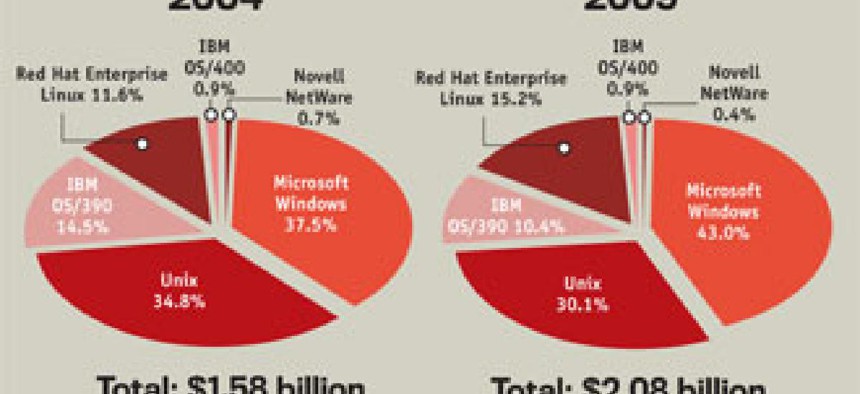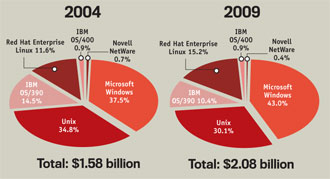An 800-pound gorilla no more?

Unix still has staying power, but Linux continues to make steady gains in the federal market.
Unix appeared more than two decades ago, promising an open alternative to the proprietary computer systems of the day. The operating system spawned the workstation market, helped make stars out of companies such as Sun Microsystems, and hastened the decline of minicomputers and their platform-specific operating systems.
Today, however, it is Unix’s turn to face the challenge of an open alternative. Open-source Linux, a Unix-like operating system, already has a solid hold in many scientific and technical computing centers. Linux and the broader open-source movement now seek to penetrate more mainstream settings.
When Linux burst onto the computing scene in the 1990s, observers expected it to be a thorn in Microsoft’s side. Indeed, Linux and other open-source tools have won some Windows converts, but Linux might be having a greater impact on Unix.
In a report published last month, IDC’s Government Insights unit predicts that the Linux share of the U.S. government’s enterprise server market will rise from 11.6 percent in 2004 to 15.2 percent by 2009. Just four years ago, Linux’s share hovered around 3 percent, the report states.
Unix’s slice of the government market is moving in the opposite direction. Government Insights’ report predicts that Unix’s market share will decline from 34.8 percent in 2004 to 30.1 percent in 2009.
Linux “is definitely stealing [market share] away from traditional Unix,” said Shawn McCarthy, a program manager at Government Insights. “Increasingly, the government is willing…to consider Linux as a viable platform to start building applications on.”
However, McCarthy and other industry watchers do not foresee the demise of Unix. “It has a strong following,” McCarthy said. “It is a secure and reliable solution in many cases. It’s going to continue to be a player.”
“The Unix market is probably twice the size of Linux,” said Mary Ann Fisher, program executive for IBM’s Global Government Industry. “We think that both of these markets are going to be out there for the foreseeable future.”
Growth at Unix’s expense
Linux servers have posted 15 consecutive quarters of double-digit growth, according to IDC’s Worldwide Quarterly Server Tracker. The firm reported that Linux server revenue grew 17 percent in the first quarter of 2006 compared with the same period last year. In that same time frame, Unix server revenue declined 7.1 percent.
A number of industry executives say the Linux upswing comes at the expense of Unix, and the annual list of the world’s fastest supercomputers supports that assertion. Unix swamped Linux in the 2000 list of the top 500 supercomputers, with 90.6 percent of the leading supercomputers running Unix and 5.6 percent running Linux. The 2006 list, published in late June, shows a dramatic role reversal: Linux now holds sway on 73.4 percent of the top-performing computers, while Unix resides on 19.6 percent.
The U.S. government operates many of the supercomputers on the top 500 list, including five of the top 10, and the National Energy Research Scientific Computing Center at the Lawrence Berkeley National Laboratory helps compile the list.
But scientific computing isn’t the only government enclave for Linux and other open-source tools. The Federal Aviation Administration said earlier this year that it had switched to Red Hat Enterprise Linux as the platform for its Enhanced Traffic Management System. It used to run on Hewlett-Packard’s Unix product, HP-UX.
Cost ranks among the top factors behind the Unix-to-Linux shift. Supercomputer centers can run Linux on clusters of low-cost servers with Intel and Advanced Micro Devices processors rather than pricey Unix-based symmetric multiprocessor machines. The FAA said it will save $15 million on its Linux migration.
The cost savings mostly stem from reduced hardware and maintenance costs. In many cases, license fees — or the lack thereof — aren’t the main driver. Numerous Linux distributions are available for free, but vendors of commercial Linux products charge for support.
“Very few government users are using [the free Red Hat-sponsored] Fedora or the nonsupport versions of Linux,” said Michael Fitzmaurice, a high-performance computer technologist at the reseller GTSI. “So they are actually paying a support fee, which is similar to a license fee. The big savings is coming from the hardware side.”
“The licensing fee, generally speaking, isn’t the largest item in that mix,” said Paul Smith, vice president of Red Hat’s government sales operations. He added that it’s more important for customers to be able to move their operating environments to hardware that costs less and is more economical to maintain. “It is a [total-cost-of-ownership] story,” he said.
The availability of applications that run on Linux has also propelled the platform’s success. Many enterprise customers are running new Linux versions of their Oracle and SAP business software, such as enterprise resource planning applications.
“We shipped more SAP applications for deployment on Linux than any other Unix platform in 2005,” said Hank Kehlbeck, director of SAP’s NetWeaver solutions. At government agencies, about 10 percent of the company’s deployments run on Linux.
“We think that is going to continue to grow,” Kehlbeck said. “It’s definitely broadening from that core base of science and technology applications into more of the mission-critical and business applications areas.”
Some executives cited hardware independence as another Linux draw. Openness and portability were early Unix watchwords, but commercial Unix fragmented in the 1980s as vendors sought to optimize the operating system to run on their respective hardware products. The move had the effect of locking customers into one vendor’s platform.
The Linux community aims to prevent the operating system from going in proprietary directions. Lee Koepping, senior solutions architect at integrator Apptis, cited freedom of hardware choice as one of the factors behind Linux’s rise.
Not black and white
Linux may be chipping away at Unix’s base, but in the government market at least, that base remains significant.
Koepping said his company often deals with federal customers for whom Unix remains prevalent. “They’ve built and specified to [Sun’s Unix-based] Solaris, and they are reluctant to move away,” he said. He added that the reason they stay is a fear of extra cost and complexity.
The Army has many systems running on Solaris, said Koepping, who added that the Marine Corps has a sizable Solaris installation as well.
But organizations adopting Linux might not abandon Unix entirely. NASA’s Jet Propulsion Laboratory, for example, has migrated its e-mail system from Sun hardware and Solaris to HP servers and Red Hat Enterprise Linux. But even though the use of Linux on production servers is growing, the practice isn’t yet the norm at the laboratory, said Douglas Hughes, a service engineer at JPL Information Services. “JPL is a huge Solaris house,” he said.
Hughes’ area has seen some Linux migration, but has no formal program to replace Solaris servers with Linux. “Application owners greenlight Linux as an OS because an increasing number of [commercial] software compatibility [lists] contain Linux” — specifically Red Hat Enterprise Linux Versions 3 and 4, he said.
In other words, user preference drives operating system choice, and thus far, users are tapping both Linux and Unix. In a recent illustration, JPL implemented a systems engineering tool called Cradle on an HP blade server running Red Hat Enterprise Linux 4. At the same time, Hughes’ group implemented the FioranoMQ Java messaging server on Sun hardware and Solaris 9 operating system.
“It was customer preference, because both [commercial offerings] support both platforms,” Hughes said.
The notion that Unix and Linux aren’t mutually exclusive hasn’t been lost on system vendors. IBM, for one, said it will continue to back both AIX — its flavor of Unix — and Linux.
“Our strategy is to invest in both of those markets across our hardware, software and services platforms,” Fisher said. On the hardware side, IBM supports Unix and Linux across its System x Intel- and AMD-based servers, System p servers using IBM’s Power chip technology, and System z mainframe-class machines.
Silicon Graphics Inc.’s take is somewhat different. The company continues to support its Unix variant, Irix, but its main focus is Linux.
“We made a strategic decision a few years back to focus on Linux as a primary OS going forward,” said Bill Mannel, SGI’s director of systems marketing. “All of our new development is centering on Linux.”
SGI’s initial Linux offering, Altix, debuted in 2003. At the time, the open-source community didn’t offer all of the high-performance, high-availability features SGI sought to provide on its hardware systems. So SGI used Red Hat Linux as Altix’s base and added the missing elements, Mannel said.
Today, the Linux community “supports all the things we need to get supported on those systems,” he said. As of early 2005, Red Hat and Novell’s SUSE Linux ran on SGI hardware right out of the box, he added.
At Sun, the company has come to accept Linux and last year recast Solaris as an open-source product. The Sun-sponsored OpenSolaris project is based on a subset of Solaris’ source code, according to the project’s Web site. Now that Solaris has entered the open-source field, Simon Phipps, Sun’s chief open source officer, said the Linux vs. Unix discussion is no longer relevant. “The category distinctions that I’ve heard people making between Unix and Linux aren’t terribly helpful anymore,” he said. “The market has moved on now.”
Or perhaps the market has just returned to an earlier vision of openness.
NEXT STORY: OMB refines use of architectures






